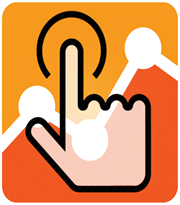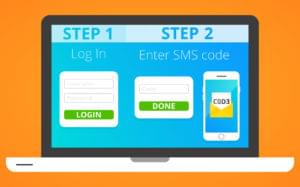3 Breakthrough Ways to Visualize HTML5 Audio
Key Takeaways
- HTML5 Audio allows for high-level audio stream management, including play and pause controls, timeline position, and volume level control, but doesn’t provide a low-level API for more complex tasks such as synchronizing audio samples.
- Preprocessing is an efficient method for visualizing audio with HTML5. By analyzing the audio stream first, data can be generated for a visualization that’s synchronized with the audio playing in the background.
- Practical examples of HTML5 audio visualization include the song ‘Chell in the Rain’, where song lyrics appear in sync with the audio stream using an array of timings and lyrics, and Grant Skinner’s Music Visualizer, which extracts volume level data from an MP3 file for visualization.
Today, HTML5 is kind of like a TV series without any future seasons written yet.
It has some episodes already filmed, some raw material that needs to be edited, some shots that are in line for cool special effects, and many, many rough drafts. Yeah, I’m talking about the whole HTML5 story, not just the spec, but hopefully you get the idea.
I’m going to focus on one interesting scenario that isn’t directly covered by the HTML5 standard, but is in high demand and visually impressive. It’s audio visualization using HTML5 Audio like this:

In my TV series analogy, audio visualization (specifically low-level API to access an audio stream) falls squarely between early drafts and ideas for future series.
What you can do with Audio … and what you can’t
The Audio element in HTML5, as you may already have guessed, doesn’t provide low-level API. It does allow you to manage the audio stream playback on a high level: play and pause, set and get current position on the timeline, know total duration, work with text tracks, and control volume level.
If you try to do anything more complex than playing a single music file with Audio—like synchronizing audio samples—you’ll realize it’s not as easy as you’d like it to be.
There are also limitations around other audio tasks that you might want to implement on your site:
- Support for multiple file formats or codecs like MP3 and H.264
- Browser features for controlling music players
- Browser pre-processing and network testing
As you can see, it depends not only on the spec itself, but also on real implementation in real browsers.
Future standards for audio … maybe

There is an initiative happening to provide the low-level API for audio stream by the Audio Working Group at W3C.
“The audio API will provide methods to read audio samples, write audio data, create sounds, and perform client-side audio processing and synthesis with minimal latency. It will also add programmatic access to the PCM audio stream for low-level manipulation directly in script.”
So, maybe someday in the future, we’ll see a common, standards-based solution for audio stream manipulations.
In the meantime, let’s come back to the real world and dive into what we can do with HTML5 today.
Practical approach: what can I do today?
First of all, what exactly do you need to build a visualization? You need some data that is time-aligned with the audio playback. It could be textual information like lyrics, data representing volume levels, or any other data you want to play with.
Where can you get data? The practical way is preprocessing. Yeah! So simple and trivial …
Basically, you’ll need to do some homework if you want to visualize audio. Analyze your audio stream first, and then you’ll be able to generate a visualization synchronized with the audio playing in the background.
For example, if you want to extract semantically important data (like lyrics for a song), preprocessing is the only possible solution (unless you have enough skilled AI to understand words and sentences in a song).
Usually, it’s a tedious, manual task. You sit down, turn on your audio player, start playing the song, remember a line, pause, write it down, look at the timer, write down current time … and do it again and again. Sometimes, you can just pull it from the Internet somewhere.
The fact is, preprocessing is just plain efficient. Using this approach saves computational resources and consequently reduces the load on the client side. That means that you should compute (or write) your data for audio visualization only once, then just use this data to make your magic happen anytime you want.
Now let’s see how it works in real life…
Dealing with real-world examples
To familiarize yourself with all the great solutions I’ll address in a moment, you can use the developer tools in your favorite browser. Internet Explorer provides great devtools for this purpose – just press F12. You can use the Scripts panel to look into JavaScript code, debug it, set breakpoints, or run your own code in the console.

Sometimes you will need to deal with compacted (or minified) code. In that case, just press “Format JavaScript” to make it more readable.

Example #1: Chell in the Rain

Chell in the Rain is a stunning audio-textual visualization of the song Exile Vilify created by Matthew Merkle. You’ll see the lyrics for the song appear in perfect sync with the audio stream.
What’s inside
- jQuery + Sizzle.js (building jQuery)
- jPlayer (a library to play Audio and Video)
- And some code that we’re interested in ;)
How it works
The song is split into a few fragments or timeframes (or timings) pointing to the beginning of a phrase or some animation. All the timings are stored in an array:
var timings = newArray(); timings[0] = 11.5; timings[1] = 17; timings[2] = 24; timings[3] = 29; timings[4] = 35.5;
In parallel, there is an array of lyrics:
var lyrics = newArray(); lyrics[0] = 'Exile'; lyrics[1] = 'It takes your mind... again'; lyrics[2] = "You've got sucker's luck"; lyrics[3] ='Have you given up?';
Now the current time on the playback can be linked with the timings array and fire a corresponding event trigger to jump for the next phrase:
if(event.jPlayer.status.currentTime >= timings[currentTrigger] && nolyrics != true) {
fireTrigger(currentTrigger);
currentTrigger++;
}
Next, the fired trigger makes some animations using jQuery:
function fireTrigger(trigger) {
switch (trigger) {
case 0:
$('#lyrics1 p').addClass('vilify').html(lyrics[0]).fadeIn(1500);
break;
case 1:
$('#lyrics2 p').html(lyrics[1]).fadeIn(1000).delay(5000).fadeOut(1000);
$('#lyrics1 p').delay(6000).fadeOut(1000);
break;
case 2:
$('#lyrics1 p').fadeIn(1000);
break;
case 3:
$('#lyrics2 p').fadeIn(1000).delay(4000).fadeOut(1000);
$('#lyrics1 p').delay(5000).fadeOut(1000);
break;
case 4:
$('#lyrics1 p').removeClass('vilify').html(lyrics[2]).fadeIn(1000);
break;
case 5:
$('#lyrics2 p').html(lyrics[3]).fadeIn(1000).delay(3000).fadeOut(1000);
$('#lyrics1 p').delay(4000).fadeOut(1000);
break;
...
It is quite simple and very effective.
Notice how easily you can mix audio stream playback and features of HTML, CSS and JavaScript.
Example #2: Extracting audio data

In his blog post Music Visualizer in HTML5 / JS with Source Code, Grant shares his experience with audio visualization using HTML5.
Since HTML5 Audio doesn’t provide any API to extract low-level data from audio files, Grand wrote a small AIR application (with samples) to help us extract the data on volume levels from an MP3 file, then store it in a text file or an image.
Zoomed in, the volume levels data looks like this:

Now, with this image, we can easily extract all the data we need using HTML5 Canvas. And it is much easier for text files—I’m not showing it as it makes no sense to read it yourself as all the data is compressed.
To work with this type of preprocessed data, Grant also wrote a small JS-library (VolumeData.js, part of the .zip I downloaded above).
To visualize something, you need to load the data first:
loadMusic("music.jpg");
The function loadMusic just loads the image:
function loadMusic(dataImageURL) {
image = new Image();
image.src = dataImageURL;
playing = false;
Ticker.addListener(window);
}
Now you should create a new VolumeData object:
volumeData = new VolumeData(image);
And then on each time update, you can do everything you want using average volume data for current time or separate data for each of the channels (left and right):
var t = audio.currentTime; var vol = volumeData.getVolume(t); var avgVol = volumeData.getAverageVolume(t-0.1,t); var volDelta = volumeData.getVolume(t-0.05); volDelta.left = vol.left-volDelta.left; volDelta.right = vol.right-volDelta.right;
All visual effects are done based on this data. For visualization, Grant is using the EaselJS library. Here are some samples: Star Field and Atomic.
Now you have all the tools you need to make cool audio visualizations.
To sum up: Use preprocessing to make your solution more efficient. Try combining audio playback with textual data, animations, and graphic effects based on the volume levels data to make compelling user experiences. Make it look like it’s magic!
Additional resources and more information:
Unlocking the power of HTML5 Audio, on the IE team blog, describes the basics steps and best practices for working with audio in HTML.
Samples in this article:
Downloads:
- Grant Skinner’s AIR application(.zip)
- Sizzle.js
- jPlayer Library
- Easel JS Library
Frequently Asked Questions on Visualizing HTML5 Audio
How can I use HTML5 for data visualization?
HTML5 provides several features that can be used for data visualization. The most commonly used feature is the Canvas API, which allows for dynamic, scriptable rendering of 2D shapes and bitmap images. It is a low-level, procedural model that updates a bitmap and does not have a built-in scene graph. Another feature is SVG (Scalable Vector Graphics), which is a language for describing 2D graphics in XML. SVG allows for three types of graphic objects: vector graphic shapes, images, and text.
What is the role of HTML5 in industrial automation?
HTML5 plays a significant role in industrial automation by providing a platform for creating interactive and dynamic web applications. It allows for real-time data visualization, which is crucial in monitoring and controlling industrial processes. HTML5 also supports cross-platform compatibility, meaning that applications can run on different devices and operating systems.
Can I use HTML5 Canvas for data visualization?
Yes, HTML5 Canvas is a powerful tool for data visualization. It allows you to draw graphics on a web page on the fly. With JavaScript, you can create charts, graphs, and other visual representations of data. However, it requires a good understanding of both HTML5 and JavaScript to use effectively.
What is D3.js and how does it relate to HTML5?
D3.js is a JavaScript library for creating data visualizations. It leverages the capabilities of HTML5, CSS, and SVG to bring data to life. D3.js allows you to bind arbitrary data to a Document Object Model (DOM), and then apply data-driven transformations to the document.
How can I use Chart.js with HTML5 for data visualization?
Chart.js is a JavaScript library that uses the HTML5 canvas element to draw different types of charts. To use Chart.js, you need to include it in your HTML document, create a canvas element for the chart, and then create a new Chart object, passing the context of the canvas and an object containing the configuration options for the chart.
How can I visualize audio data with HTML5?
HTML5 provides the Web Audio API, which can be used to visualize audio data. The API provides a way to create, manipulate, and analyze audio data directly in the browser. You can use the AnalyserNode interface to capture time domain and frequency data from the audio source, and then use this data to create visualizations.
What are the benefits of using HTML5 for data visualization?
HTML5 offers several benefits for data visualization. It supports interactive graphics, which can make data more engaging and easier to understand. It also supports real-time data updates, which is crucial for applications that require up-to-the-minute data. Additionally, HTML5 is cross-platform compatible, meaning that visualizations can be viewed on any device with a modern web browser.
Are there any limitations to using HTML5 for data visualization?
While HTML5 offers many benefits for data visualization, it also has some limitations. For example, complex visualizations may require advanced knowledge of HTML5 and JavaScript. Additionally, performance can be an issue for large or complex data sets, as rendering many elements can slow down the browser.
Can I use HTML5 to create interactive data visualizations?
Yes, one of the key advantages of HTML5 is its support for interactivity. You can use JavaScript in conjunction with HTML5 to create interactive charts, graphs, and other visualizations. This can make your data more engaging and easier to understand.
How can I learn more about using HTML5 for data visualization?
There are many resources available to learn about using HTML5 for data visualization. Online tutorials, courses, and documentation can provide a good starting point. Additionally, libraries like D3.js and Chart.js provide examples and documentation that can help you get started.
Konstantin Kichinsky works at Microsoft Russia as Academic Developer Evangelist with special focus on HTML5 and IE, and apps design and UX for Windows Phone. Catch his blog here.

Published in
·Design·Design & UX·Patterns & Practices·Performance·Software·Technology·UX·Web·January 12, 2015
Published in
·Design·HTML & CSS·Mobile·Mobile UX·Mobile Web Development·Responsive Web Design·July 2, 2014
Published in
·Development Environment·Patterns & Practices·PHP·Programming·Web·Web Security·August 13, 2014

Published in
·APIs·Authentication·CMS & Frameworks·Frameworks·Laravel·Libraries·Patterns & Practices·PHP·Security·Web Services·February 28, 2017



